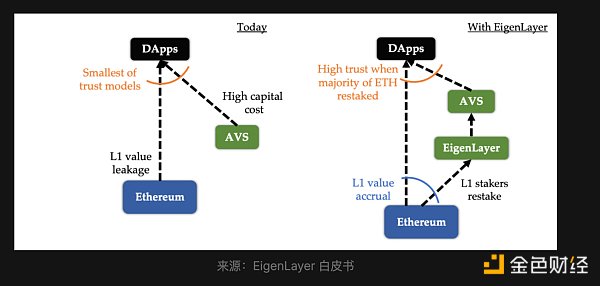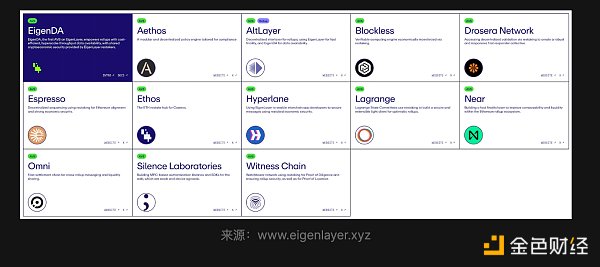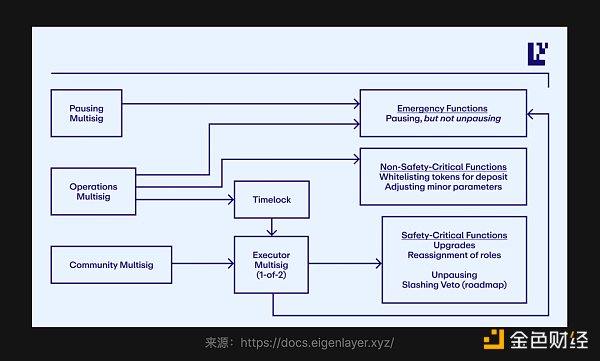以太坊历史性时刻 深度解析再质押与EigenLayer
作者:Eda 来源:edatweets.eth 翻译:善欧巴,比特币买卖交易网
毫无疑问,Restaking(再质押)是2024年以太坊的一个关键议题。这个术语是由EigenLayer引入的,该项目在以太坊世界迅速成为一个热门话题。
几个月前,我曾写过有关EigenLayer的文章。从那时起,发生了很多事情,人们的兴趣呈指数级增长。因此,我将以另一篇文章回归,深入探讨以下内容:
EigenLayer的全面概述:它是什么以及为什么你应该关注它
当前状态:目前有什么新动态
风险:我们应该注意什么。
第 1 部分 - EigenLayer:全面概述
EigenLayer是一种再质押协议,因其在以太坊领域的新颖和创新方法而受到广泛关注。
让我们首先解决 EigenLayer 想要解决的问题。
EigenLayer:简化网络引导
股权证明 (PoS)网络通常要求运营商运行节点,并通过代币支持来激励他们的努力。启动这样一个网络涉及许多复杂性。其中的关键是设计有效的代币、确保其公平分配、获得市场接受以及监管等等。这些因素共同限制了基础设施层面的创新。
这正是 EigenLayer 的用武之地 - 解决与基础设施级创新相关的挑战。
其核心理念是利用以太坊已建立的经济信任作为为先进项目构建基础设施组件的基础。为此,EigenLayer 重新定义了 PoS 网络的引导过程。

EigenLayer如何工作?
EigenLayer允许开发人员利用以太坊现有的经济安全基础设施,其中包括验证器集和资本。这一过程利用以太坊已经建立的安全性,简化了新网络和服务的创建。

其中的核心是“再质押”的概念。通过重新质押,EigenLayer 可以将以太坊质押的 ETH 和验证器集用于其他服务和网络。
为什么这很重要?
简化网络和服务的开发: EigenLayer 允许再质押 ETH 的方法简化了建立新网络的过程。它为这些网络提供了即时的经济安全和运营支持,无需开发人员从头开始引导这些元素。这不仅加速了网络发展,还降低了准入门槛,为更广泛的网络和服务铺平了道路。
新的质押机会:该模型为 ETH 质押者提供了使用其资产的新方式,可能会带来额外的奖励。
验证者利用:该模型为验证者提供了利用现有资源的新机会。通过参与多个网络,他们可以最大化其效用并扩大其盈利潜力。
详细概述:角色、机制和影响
下面详细介绍了该系统的工作原理:
以太坊质押
目前,以太坊网络由验证者保证安全,验证者将其 ETH 作为遵守以太坊规则的基于资本的承诺。验证器负责存储数据、处理交易以及通过运行验证器软件向区块链添加新块。如果他们不遵守规则,那么他们就有失去这些 ETH 的风险。要成为验证者,至少需要 32 ETH。然而,对于那些无法达到这个门槛的人来说,可以选择通过参与质押池来贡献少量的 ETH,该池就像由其他人管理的团体基金。
EigenLayer(重新)质押
EigenLayer 更进一步。它扩展了验证者的角色,让他们参与需要外部运营商的新网络和系统。通过这样做,质押者可以获得额外的奖励,从而增加他们对以太坊生态系统的参与度,并为他们提供获得奖励的新途径。
在继续之前,让我们先澄清参与者及其角色。
参与者和角色
质押者:他们是承诺将 ETH 用于支持新网络和服务的人。他们有两个选择:
原生重新质押:质押者可以通过承担贡献代币和操作以太坊验证节点的责任来独立操作。
委托给运营商(又名流动性再质押):质押者可以将他们的 ETH 委托给运营商,重点关注财务支持,而运营商则处理技术要求。
操作员:这些参与者管理和运行构建在 EigenLayer 之上的软件。他们在维护网络完整性方面发挥着至关重要的作用,并会因任何不当行为而受到处罚。
服务:这些是由运营商运行的网络和服务 - 它们被称为主动验证服务(AVS) - 下一节将详细介绍这一点。
服务消费者:这些是使用 EigenLayer 提供的服务的最终用户或应用程序。
我提到了“网络和服务”,但在 EigenLayer 的背景下这些类别到底属于什么?
了解主动验证服务 (AVS)
主动验证服务是需要外部运营商运营其网络的服务。AVS 的示例包括数据可用性层、去中心化排序器、网桥、预言机等。
这些服务不仅仅是被动的实体,而且是被动的。他们有特定的运营需求。这包括:
某些节点软件要求
定义削减(即对恶意行为的惩罚)发生的条件。

Slashing:确保 EigenLayer 的诚实
在 EigenLayer 中,利益相关者和运营商之间的合作至关重要。当 Stakers 委托他们的 ETH 时,他们明确信任运营商会诚实行事。
为了让每个人都保持诚实,EigenLayer 有一种称为“削减”的机制。如果运营商做了不该做的事情,他们可能会受到处罚。这意味着他们可能会损失一些投入的 ETH。
AVS 智能合约中定义了惩罚条件,并对违反规则的行为进行处罚。例如,运营商面临着因侧链双重签名或桥接器签署不存在消息等行为而受到大幅处罚的风险。
这种机制保证了系统的完整性和可信性。
Trust Bazaar:EigenLayer 的去中心化市场
简而言之,EigenLayer通过获取以太坊的信任(资本 + 验证器集)并将其组件提供给任何感兴趣的人,创建了一个去中心化的信任市场。通过这种机制,利益相关者可以选择提供新服务,为他们带来额外的好处。

第 2 部分 - 当前状态:特征层
当前主网上线和总锁定价值
EigenLayer 分多个阶段推出其平台,首先是在主网上重新质押,然后引入运营商,最后是推出 AVS。
他们于 2023 年 6 月在以太坊主网上推出了再质押功能。截至撰写本文时,已有648,964.0315 ETH 被质押 (超过 10 亿美元!) ,您可以在仪表板上关注它,显示代币的细分。
此阶段从采用受保护的方法开始,在各个阶段测试协议。现在,EigenLayer 允许您通过多个 LST 和本机再质押进行流动性抵押。
AVS世界
各个团队都在积极开发 AVS,其中 EigenLayer 的EigenDA就是一个显着的例子。除了来自Espresso、Witness Chain、Omni和Lagrange的团队,您还可以在这里了解更多信息。
请注意,AVS 通常不是消费者应用程序,而是面向消费者的应用程序所需的服务。例如预言机、共享序列、桥梁。- 我们不会为了这篇文章而深入研究,而是为了未来。

EigenDA
EigenDA 是 EigenLayer 正在构建的数据可用性服务,也是第一个在 Goerli 测试网上启动的 AVS。
这是第二阶段发布的一部分,包括运营商运行 EigenDA 的验证服务,演示服务如何在 EigenLayer 上运行。
目前,发布仅限于测试网。EigenDA 尤其重要,因为它将是 EigenLayer 上的第一个服务。
关于重质押的注释
虽然“重质押”一词用于描述在 EigenLayer 上质押以 ETH 为面值的代币,但它本质上是一个无许可的质押平台。最初的重点是 ETH 为面值的代币,但可以扩展到其他形式的资产,例如不同的代币。这种选择是为了支持以太坊生态系统,以及 ETH 相对较低的波动性。虽然平台不必绑定于 ETH 和以 ETH 为面值的代币,但最初的策略是从这些开始。
第 3 部分 - 风险和重新评估以太坊的激励措施
重新评估激励措施
几个月前,Vitalik 写了一篇文章,讨论将以太坊共识机制扩展到其原始范围之外的潜在风险和影响。这里的核心信息是,虽然以太坊的共识机制是维护去中心化和安全区块链的强大工具,但将其用于超出其预期目的的决策可能会带来风险和挑战,从而破坏系统的稳定性和信任。
类似地,Justin Drake 在 Devconect 期间做了演讲,讨论了相关问题和潜在的解决方案。我强烈建议您观看此内容,它对潜在风险和缓解措施进行了非常有见地的概述(特别是如果您对 MEV 有一定背景的话)。
重新质押的关键问题是质押协议如何通过提供超出核心协议可见性的奖励来改变以太坊验证者的激励,以及这是否会改变以太坊的基本价值主张。
例如:
通过重新质押获得额外收入机会的吸引力可能会增加对质押 ETH 的需求,从而影响以太坊网络的整体经济。
在对网络和服务有很高的节点要求的情况下,通过参与 EigenLayer 的质押获得更高收益的潜力可能会使单独质押的选择不再那么有吸引力——这意味着并非每个验证者都可以选择提供更好的服务返回。另一方面,如果提供不同的激励机制,它可以使单独质押更具竞争力和资本效率。
承认像这样的尖端技术可能会遇到一些最初的挑战 - 因此我持保留态度,看到如此不同的东西仍然非常令人兴奋。新想法和可能性层出不穷。
特征层风险
以下是一些值得注意的风险和更多背景信息:
操作员集中化
运营商之间的公平与奖励分配
操作人员不当行为和系统安全风险
流动性质押的复杂性和信任问题
智能合约风险
操作员集中化
EigenLayer 的主要担忧之一是操作员集中化的风险。如果对运营商有很高的链下要求,就会出现这个问题,可能导致资源和专业知识集中在有限的运营商群体中。这种情况可能会降低以太坊上单独质押的吸引力和可行性。换句话说,如果作为“委托重试者”参与的奖励高于成为单独重试者,则可能会阻碍单独质押。
运营商之间的公平与奖励分配
需要考虑的一个关键方面是运营商之间奖励分配的公平性。在 EigenLayer 中,运营商可以选择各种服务,每种服务提供不同的潜在奖励。这种设置可能会显着改变以太坊当前的“公平”奖励系统,其中每个节点通过抵押 ETH 获得相似的年利率。不同的奖励结构可能会激励运营商专注于回报最大化,从而很难为所有网络验证者维持一个平衡和公平的环境。现在,验证者需要做更多的工作来了解项目和奖励结构 - 一个月他们可以选择加入某个 AVS,然后再选择另一个,不断寻找更好的东西。
(补充中心化的论点 - 由于奖励分配不同,对于本地重试者来说,选择委托给操作员而不是自己运行软件,从而改变核心协议上的验证器分配可能是有意义的。)
操作人员不当行为和系统安全风险
操作员不当行为的可能性是一个重大风险。鉴于运营商可以参与多个 AVS,如果奖励 > 惩罚会发生什么。那么经营者就可以选择不诚实地行事并愿意失去股份。如果参与的运营商数量较少,则可能会聚集在一起进行攻击(攻击>损失)。(在某些情况下,您可以想象参与 AVS 所需的股份可能超过成为 ETH 验证者的 32 ETH,这可能会限制运营商的数量)。
此外,如果 EigenLayer 中重新平衡抵押品的机制因调整缓慢、延迟或参数不正确而失败,则可能会使系统面临各种安全风险。为了抵消这种风险,EigenLayer 提出了“解绑期”解决方案。这种方法在质押者请求撤回其质押的时间与他们实际可以访问质押的时间之间引入了强制延迟。(这是 EigenLayer 的一篇文章,解释了他们的方法)所提出的解决方案似乎可以有效解决恶意操作者过早退出的漏洞。EigenLayer 正在积极完善这一复杂机制,以增强解决这一潜在风险的安全性和有效性。
流动性再质押的复杂性和信任问题
当利益相关者使用外部运营商并需要选择 AVS 时,复杂性就会出现 - 利益相关者希望支持哪种 AVS?EigenLayer 的解决方案涉及运营商为其支持的每个 AVS 组合使用不同的地址(例如,使用 2 个 AVS 的运营商可以有 3 个地址:AVS 1、AVS 2 以及两者 -此处解释)。虽然这允许质押者保留对其质押的控制权,但它在理解哪个地址代表哪个或哪些服务方面引入了一层复杂性。此外,与任何无需许可的区块链一样,“我可以信任运营商吗”的问题仍然存在。
智能合约风险
EigenLayer 或 AVS 的智能合约中的错误和问题可能会带来无意中被削减的潜在风险。为了减轻智能合约风险,EigenLayer 依靠治理委员会来解决因意外削减而导致的问题。委员会可以逆转由于错误或恶意代码而导致的削减。

结语
还有很多研究要做,包括完善 AVS、将这些系统付诸实践,以及以强化以太坊核心价值的方式设计协议。虽然 EigenLayer 的解决方案很有前景,但它们必须在有效性和可控复杂性之间取得平衡,以确保系统的可靠性。
我尽力避免使用已经沦为模因的“以太坊对齐”,但仍然希望我的信息能传达清楚。竭尽全力避开那些新炒作、模糊不清的术语
看到 EigenLayer 让以太坊世界涌现出如此多的新事物,真是令人兴奋。再质押是 2024 年以太坊的主要叙事之一,也赞叹 EigenLayer 团队让我保持兴奋。
There is no doubt that re-pledge is a key topic in Ethereum in 2008. This term was introduced by, and the project has quickly become a hot topic in the world of Ethereum. I wrote an article about it a few months ago. Since then, many things have happened, and people's interest has increased exponentially. Therefore, I will return to another article to discuss in depth the following contents: what it is and why you should pay attention to its current state and what's new. What risks should we pay attention to? The first part is a comprehensive overview. It is a kind of re-pledge protocol, which has attracted wide attention because of its novel and innovative methods in the field of Ethereum. Let's first solve the problems we want to solve, simplify the network and guide the equity certification network. Usually, operators are required to run nodes and encourage their efforts to start such a network through token support. The key is to design effective tokens to ensure their fair distribution, market acceptance and supervision. Together, it limits the innovation at the infrastructure level, which is the right place to solve the challenges related to the innovation at the infrastructure level. Its core idea is to use the established economic trust of Ethereum as the basis for building infrastructure components for advanced projects. Therefore, it redefines how the network guidance process works, allowing developers to use the existing economic and security infrastructure of Ethereum, including the verifier set and capital. This process simplifies the new network and services by using the established security of Ethereum. The core of the creation is the concept of re-pledge. Through re-pledge, Taifang's pledged and verifier set can be used for other services and networks. Why is this important to simplify the development of networks and services? The method of allowing re-pledge simplifies the process of establishing new networks. It provides immediate economic security and operational support for these networks, and developers do not need to guide these elements from scratch, which not only accelerates the development of networks, but also lowers the entry threshold, paving the way for a wider range of networks and services. The model provides the pledgee with a new way to use its assets, which may bring additional rewards. Verifiers use this model to provide the verifier with new opportunities to use existing resources. By participating in multiple networks, they can maximize their utility and expand their profit potential. The following details the working principle of the system, the role mechanism and influence. At present, the Ethereum network is guaranteed by the verifier, and the verifier regards it as a capital-based one that abides by the rules of Ethereum. The commitment verifier is responsible for storing data processing transactions and adding new blocks to the blockchain by running verifier software. If they don't follow the rules, they risk losing these. To become a verifier, they need at least. However, for those who can't reach this threshold, they can choose to contribute a small amount by participating in the pledge pool, just like the group fund managed by others is re-pledged. It expands the role of verifiers and allows them to participate in new networks that require external operators. By doing so, the system can get additional rewards for the pledgee, thus increasing their participation in the Ethereum ecosystem and providing them with new ways to get rewards. Before continuing, let's clarify the participants and their role participants and role pledgees. They are the people who promise to support the new network and services. They have two choices: the original pledgee can independently operate by taking the responsibility of contributing tokens and operating the Ethereum verification node, which is also called liquidity. Pledgers can entrust their trust to operators, focusing on financial support, while operators deal with technical requirements. These participants manage and run the software built on it. They play a vital role in maintaining the integrity of the network and will be punished for any improper behavior. These services are networks and services run by operators, which are called active verification services. The next section will introduce this in detail. These are the ultimate services for consumers. Users or applications I mentioned networks and services, but in the context of what these categories belong to, I understand active authentication services. Active authentication services are services that require external operators to operate their networks, including data availability layer decentralization sorter, bridge Oracle, etc. These services are not only passive entities, but also passive. They have specific operational requirements, including some node software requirements to define the conditions for reduction, that is, the punishment for malicious acts, and ensure honesty. The cooperation between stakeholders and operators is very important. When entrusting them, they clearly trust that operators will act honestly. In order to keep everyone honest, there is a mechanism called reduction. If operators do something they shouldn't do, they may be punished, which means that they may lose some investment. The smart contract defines the punishment conditions and punishes the behaviors that violate the rules, such as the operators are faced with double signatures of side chains or non-existent messages signed by bridges. This mechanism ensures the integrity and credibility of the system. In short, a decentralized trust market is created by obtaining the trust capital verifier set of Ethereum and providing its components to anyone interested. Through this mechanism, stakeholders can choose to provide new services to bring them additional benefits. Part One: Current status, characteristics, current main online and total locked value, and its platform is launched in multiple stages. First, it is launched in the main network. Online re-pledge, and then the introduction of operators, and finally, the introduction of the re-pledge function on the main network of Ethereum in June. As of the writing of this article, more than 100 million dollars have been pledged. You can pay attention to it on the dashboard to show the breakdown of tokens. At this stage, the protocol is tested at various stages from the protected method. Now, you are allowed to conduct liquidity mortgage through multiple and local re-pledges. One of them is a remarkable example, except for the team from and you. You can also learn more information here. Please pay attention to the services that are usually not consumer applications but consumer-oriented applications, such as the Oracle sharing sequence bridge. We will not study it in depth for this article, but the data availability service that is being built in the future is also the first to be launched on the test network. This is part of the second phase of the release, including the verification service run by operators. It is particularly important to demonstrate how the service can run on the test network at present, because it will be the first service in the world. Although the word re-pledge is used to describe the pledge on the face value. 比特币今日价格行情网_okx交易所app_永续合约_比特币怎么买卖交易_虚拟币交易所平台
注册有任何问题请添加 微信:MVIP619 拉你进入群

打开微信扫一扫
添加客服
进入交流群
1.本站遵循行业规范,任何转载的稿件都会明确标注作者和来源;2.本站的原创文章,请转载时务必注明文章作者和来源,不尊重原创的行为我们将追究责任;3.作者投稿可能会经我们编辑修改或补充。


















